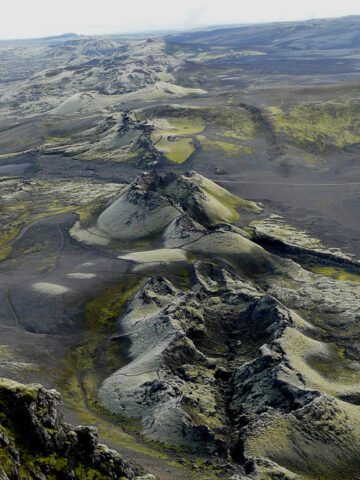The potential climate effects of large tropical volcanic eruptions have received much attention in the scientific climate community, but climate impacts of high-latitude volcanic eruptions have been less studied and are thus not as well understood. Increased understanding of high-latitude eruptions is also important from hazard mitigation and emergency planning perspectives. This was made evident by the 2010 eruption of Eyjafjallajökull on Iceland, which was relatively small but served as a reminder that it is only a matter of time before a similar or larger eruption will occur.
What is the magnitude threshold for high-latitude eruptions to have large-scale or global impacts?
A dozen climate scientists gathered at Stockholm University in November 2014 to discuss the most recent model developments and current scientific knowledge of the effects of high-latitude volcanic eruptions on climate. The aim of the workshop was to narrow down and address the most prominent uncertainties to improve model skills in predicting the effects of future large explosive volcanic eruptions. The group focused on future research priorities to answer some key questions:
- What is the magnitude threshold for high-latitude eruptions to have large-scale or global impacts?
- How does the background ocean state affect the eruption’s impact on climate?
- Does the season in which the eruption occurs matter?

New results presented at the workshop show the potential for both short- and long-term global impacts from high-latitude eruptions, as well as the importance of ocean initial states on the associated climate anomalies, demonstrating the need for additional work on the topic.
The season influences sulfate formation, and the zonal asymmetry of the polar vortex can affect the aerosol’s transport. Participants agreed that it would be useful to test different seasons and longitudes and to investigate the impact of Southern Hemisphere high-latitude volcanoes, where the polar vortex is zonally symmetric.
The eruption plume height is fundamental for aerosol microphysical evolutions in the atmosphere; however, little has been investigated in this regard for high-latitude eruptions. A higher spatial coverage of ice core samples would increase the signal-to-noise ratio, allowing evaluation of model skills in simulating aerosol formation, transport, and deposition. These combined efforts will provide better constraints on sulfur dioxide emission amounts and plume height estimates.
Additional key questions were as follows:
- Are we ready for the next “big one”?
- What will be the consequences for society in terms of the climate and health impacts of such an event?
Fissures that opened up in 1783 along the flanks of Laki volcano in Iceland caused thousands of deaths across Europe and North Africa due to severe air pollution and to poisoning by volcanic gases. What would happen today?
It is extremely relevant from mitigation and adaptation strategy points of view to quantify the potential impacts on health of such eruptions. For example, fissures that opened up in 1783 along the flanks of Laki volcano in Iceland caused thousands of deaths across Europe and North Africa due to severe air pollution and to poisoning by volcanic gases. What would happen today? Participants contemplated this question, noting that modern societies may have increased resilience but that only a few studies have been conducted on how catastrophic eruptions could affect populations.
Sensitivity studies exploring all of the above-mentioned aspects might be model dependent. Hence, it is important to investigate climate effects of high-latitude eruptions in a multimodel framework, as proposed in the new Volcano Model Intercomparison Project (VolMIP). Modeling strategies were defined during the Stockholm workshop and could serve as an important contribution to VolMIP.
Acknowledgments
I thank the International Meteorological Institute and the Bolin Centre for funding the workshop and Myriam Khodri, Claudia Timmreck, Alan Robock, Anja Schmidt, Kristin Krüger, David S. Battisti, Odd Helge Otterå, and Marius Simonsen for their contributions.
—Francesco S. R. Pausata, Department of Meteorology and Bolin Centre for Climate Research, Stockholm University, Stockholm, Sweden; email: [email protected]
Citation: Pausata, F. S. R. (2015), How do high-latitude volcanic eruptions affect climate?, Eos, 96, doi:10.1029/2015EO025757. Published on 11 March 2015.
Text © 2015. The authors. CC BY-NC-ND 3.0
Except where otherwise noted, images are subject to copyright. Any reuse without express permission from the copyright owner is prohibited.

